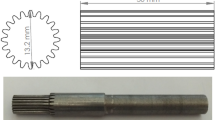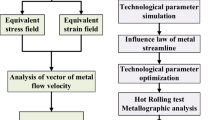Abstract
The advantages of the flow-forming process, such as excellent mechanical properties, simple tools, and the need for low forming force, have led to the increasing use of this process in various industries, especially in the military, aerospace, and automotive industries. New application of this process is the internal gear flow-forming process (IGFP), in which the gear is produced with simple tools and low forming force. In this paper, IGFP was studied by the finite element method and experiments. Experiments include tensile test (determine stress-strain curve of the material), ring compression test (determine friction coefficient), flow-forming test, and metallography. The material was considered elastic-plastic, and the Coulomb friction model was used to simulate the friction between surfaces. IGFP was performed by a simple setup. Teeth height and gear profile were measured and compared to simulated values, and there is a good agreement between the simulation and experimental results. Once the simulation is verified, the effects of process parameters (feed rate, roller diameter, attack angle of the roller, and thickness reduction percentage) on the process temperature were obtained using the design of experiments (DOE). According to DOE results, thickness reduction percentage (T) and roller diameter (D) have the most significant effect on process temperature. Finally, a function for process temperature was obtained versus input parameters, and this function was optimized by the firefly algorithm.



















Similar content being viewed by others
References
Srinivasulu M, Komaraiah M, Krishna Prasada Rao CS (2013) Prediction of the surface roughness of AA6082 flow-formed tubes by design of experiments. J Mech Sci Technol 27(6):1835–1842. https://doi.org/10.1007/s12206-013-0434-y
Bhatt RJ, Raval HK (2018) In situ investigations on forces and power consumption during flow forming process. J Mech Sci Technol 32(3):1307–1315. https://doi.org/10.1007/s12206-018-0235-4
Gao PF, Li M, Zhan M, Xing L, Ma F, Fu MW (2021) Circumferential twist in flow forming of tubular parts: Characterization, understanding and control. J Manuf Process 65:144–152. https://doi.org/10.1016/j.jmapro.2021.03.020
Podder B, Banerjee P, Kumar KR, Hui NB (2020) Forward and reverse modelling of flow forming of solution annealed H30 aluminium tubes. Neural Comput Appl 32(7):2081–2093. https://doi.org/10.1007/s00521-018-3749-x
Shi N, Wang W-x, Zhang T-t, Chen H-s, Chen W, Feng R-y (2021) Interface bonding and deformation behavior of 6061Al/AZ31Mg composite tubes fabricated by stagger spinning. Trans Indian Inst Met 74(6):1373–1385. https://doi.org/10.1007/s12666-020-02042-3
Srivastwa AK, Singh PK, Kumar S (2021) Experimental investigation of flow forming forces in Al7075 and Al2014 – A comparative study. Mater Today: Proc 47:2715–2719. https://doi.org/10.1016/j.matpr.2021.02.781
Zhang J, Wang W, Zhang T, Yan Z, Shi N (2021) Mechanical characterization of the plastic deformation behavior of AZ31 magnesium alloy processed through spinning using nanoindentation. Trans Indian Inst Met 74(6):1349–1359. https://doi.org/10.1007/s12666-021-02218-5
Riepold M, Arian B, Rozo Vasquez J, Homberg W, Walther F, Trächtler A (2021) Model approaches for closed-loop property control for flow forming. Adv Ind Manuf Eng 3:100057. https://doi.org/10.1016/j.aime.2021.100057
Gao P, Yu C, Fu M, Xing L, Zhan M, Guo J (2021) Formability enhancement in hot spinning of titanium alloy thin-walled tube via prediction and control of ductile fracture. Chin J Aeronaut. https://doi.org/10.1016/j.cja.2021.01.002
Cheng Y-C, Lin C-K, Tan A-H, Hsu S-Y, Lee S-L (2012) Effect of the spinning deformation processing on mechanical properties of Al-7Si-0.3Mg alloys. J Mater Eng Perform 21(9):1873–1878. https://doi.org/10.1007/s11665-011-0089-8
Groche P, Fritsche D (2006) Application and modelling of flow forming manufacturing processes for internally geared wheels. Int J Mach Tools Manuf 46(11):1261–1265
Khodadadi M, Khalili K, Ashrafi A (2020) Studying the effective parameters on teeth height in internal gear flowforming process. Int J Eng 33(12):2563–2571. https://doi.org/10.5829/ije.2020.33.12c.18
Khodadadi M, Khalili K, Ashrafi A (2021) Study on manufacturing of internal gear by flowforming process and investigation of effective parameters on process force. Iran J Mater Form 8(1):14–25. https://doi.org/10.22099/ijmf.2020.37889.1162
Khodadadi M, Khalili K, Ashrafi A (2022) Optimizing parameters effective on built-up edge in internal gear flowforming process. Sādhanā 47(2):99. https://doi.org/10.1007/s12046-022-01860-z
Nägele H, Wörner H, Hirschvogel M (2000) Automotive parts produced by optimizing the process flow forming – machining. J Mater Process Technol 98(2):171–175. https://doi.org/10.1016/S0924-0136(99)00195-8
Guba N, Hüsemann T, Karpuschewski B (2020) Influence of gear hobbing feed marks on the resulting gear quality after discontinuous profile grinding. CIRP J Manuf Sci Technol. https://doi.org/10.1016/j.cirpj.2020.06.005
Jiang S-Y, Ren Z-Y, Bin W, Wu G-X (2007) General issues of FEM in backward ball spinning of thin-walled tubular part with longitudinal inner ribs. Trans Nonferrous Met Soc China 17(4):793–798
Jiang S, Ren Z, Xue K, Li C (2008) Application of BPANN for prediction of backward ball spinning of thin-walled tubular part with longitudinal inner ribs. J Mater Process Technol 196(1–3):190–196
Jiang S, Ren Z, Li C, Xue K (2009) Role of ball size in backward ball spinning of thin-walled tubular part with longitudinal inner ribs. J Mater Process Technol 209(4):2167–2174
Jiang S-Y, Zheng Y-F, Ren Z-Y, Li C-F (2009) Multi-pass spinning of thin-walled tubular part with longitudinal inner ribs. Trans Nonferrous Met Soc China 19(1):215–221
Haghshenas M, Jhaver M, Klassen R, Wood J (2011) Plastic strain distribution during splined-mandrel flow forming. Mater Design 32(6):3629–3636
Haghshenas M, Wood J, Klassen R (2012) Investigation of strain-hardening rate on splined mandrel flow forming of 5052 and 6061 aluminum alloys. Mater Sci Engineering: A 532:287–294
Haghshenas M, Wood J, Klassen R (2012) Effect of strain-hardening rate on the grain-to-grain variability of local plastic strain in spin-formed fcc metals. Mater Sci Eng: A 552:376–383
Xia Q-X, Sun L-Y, Cheng X-q, Ye B-Y (2009) Analysis of the forming defects of the trapezoidal inner-gear spinning. In: Industrial Engineering and Engineering Management, IEEM 2009. IEEE International Conference on, 2009. IEEE, pp 2333–2337
Xia Q, Long J, Xiao G, Yuan S, Qin Y (2021) Deformation mechanism of ZK61 magnesium alloy cylindrical parts with longitudinal inner ribs during hot backward flow forming. J Mater Process Technol 296:117197. https://doi.org/10.1016/j.jmatprotec.2021.117197
Xu W, Zhao X, Shan D, Li J, Deng Q, Cui X, Li Z (2016) Numerical simulation and experimental study on multi-pass stagger spinning of internally toothed gear using plate blank. J Mater Process Technol 229:450–466
Ong P, Chin DDVS, Ho CS, Ng CH (2018) Modeling and optimization of cold extrusion process by using response surface methodology and metaheuristic approaches. Neural Comput Appl 29(11):1077–1087. https://doi.org/10.1007/s00521-016-2626-8
Dieter G (1986) Mechanical metallurgy. McGraw-Hill, Singapore
Zhu Y, Zeng W, Ma X, Tai Q, Li Z, Li X (2011) Determination of the friction factor of Ti-6Al-4V titanium alloy in hot forging by means of ring-compression test using FEM. Tribol Int 44(12):2074–2080. https://doi.org/10.1016/j.triboint.2011.07.001
Martín F, Martín MJ, Sevilla L, Sebastián MA (2015) The ring compression test: Analysis of dimensions and canonical geometry. Procedia Eng 132:326–333. https://doi.org/10.1016/j.proeng.2015.12.502
Moncada A, Martín F, Sevilla L, Camacho AM, Sebastián MA (2015) Analysis of ring compression test by upper bound theorem as special case of non-symmetric part. Procedia Eng 132:334–341. https://doi.org/10.1016/j.proeng.2015.12.503
Cristino VAM, Rosa PAR, Martins PAF (2015) The role of interfaces in the evaluation of friction by ring compression testing. Exp Tech 39(4):47–56. https://doi.org/10.1111/j.1747-1567.2012.00857.x
Rasouli MA, Taherizadeh A, Farzin M, Abdolah A, Niroomand MR (2017) Investigating the effects of process parameters on forming forces and defects formation in tube spinning process of AA6061. Modares Mech Eng 16(12):186–194
Crutzen Y, Boman R, Papeleux L, Ponthot J-P (2018) Continuous roll forming including in-line welding and post-cut within an ALE formalism. Finite Elem Anal Des 143:11–31. https://doi.org/10.1016/j.finel.2018.01.005
Wong C, Dean T, Lin J (2004) Incremental forming of solid cylindrical components using flow forming principles. J Mater Process Technol 153:60–66
Wong CC, Dean TA, Lin J (2003) A review of spinning, shear forming and flow forming processes. Int J Mach Tools Manuf 43(14):1419–1435. https://doi.org/10.1016/S0890-6955(03)00172-X
Gur M, Tirosh J (1982) Plastic flow instability under compressive loading during shear spinning process. J Eng Ind 104(1):17–22. https://doi.org/10.1115/1.3185791
Dieter GE (1988) Mechanical metallurgy, vol 1. Mc Graw-Hill, New York
Montgomery DC (2017) Design and analysis of experiments. Wiley, Hoboken
Yang X-S (2010) Firefly algorithm, stochastic test functions and design optimisation. Int J Bio-Inspired Comput 2(2):78–84. https://doi.org/10.1504/ijbic.2010.032124
Apostolopoulos T, Vlachos A (2011) Application of the Firefly Algorithm for solving the economic emissions load dispatch problem. Int J Combinatorics 2011:523806. https://doi.org/10.1155/2011/523806
Zang H, Zhang S, Hapeshi K (2010) A review of nature-inspired algorithms. J Bionic Eng 7:S232–S237. https://doi.org/10.1016/S1672-6529(09)60240-7
Coelho LdS, Mariani VC (2012) Firefly algorithm approach based on chaotic Tinkerbell map applied to multivariable PID controller tuning. Comput Math Appl 64(8):2371–2382. https://doi.org/10.1016/j.camwa.2012.05.007
Sababha M, Zohdy M, Kafafy M (2018) The enhanced firefly algorithm based on modified exploitation and exploration mechanism. Electronics 7(8):132
Bharathi RS, Srinivas Pramod CV, Vamshee Krishna K, Ragunathan A, Vinesh S (2015) Optimization of electrical discharge machining parameters on hardened die steel using Firefly Algorithm. Eng Comput 31(1):1–9. https://doi.org/10.1007/s00366-013-0320-3
Author information
Authors and Affiliations
Corresponding author
Ethics declarations
1. The study does not involve the sampling/participation of humans or animals in any aspect.
2. All authors made substantial contributions and contributed equally to the manuscript in all aspects.
3. The study was not funded by any funding organization.
4. The authors declare that there is no conflict of interest.
5. The datasets generated, and/or analyzed during the current study are available from the corresponding author on reasonable request.
Additional information
Publisher’s Note
Springer Nature remains neutral with regard to jurisdictional claims in published maps and institutional affiliations.
Rights and permissions
Springer Nature or its licensor (e.g. a society or other partner) holds exclusive rights to this article under a publishing agreement with the author(s) or other rightsholder(s); author self-archiving of the accepted manuscript version of this article is solely governed by the terms of such publishing agreement and applicable law.
About this article
Cite this article
Khodadadi, M., Khalili, K., Ashrafi, A. et al. Investigation of Hardness, Microstructure, and Process Temperature in the Internal Gear Flow-Forming Process. Exp Tech 47, 1169–1182 (2023). https://doi.org/10.1007/s40799-022-00622-0
Received:
Accepted:
Published:
Issue Date:
DOI: https://doi.org/10.1007/s40799-022-00622-0




